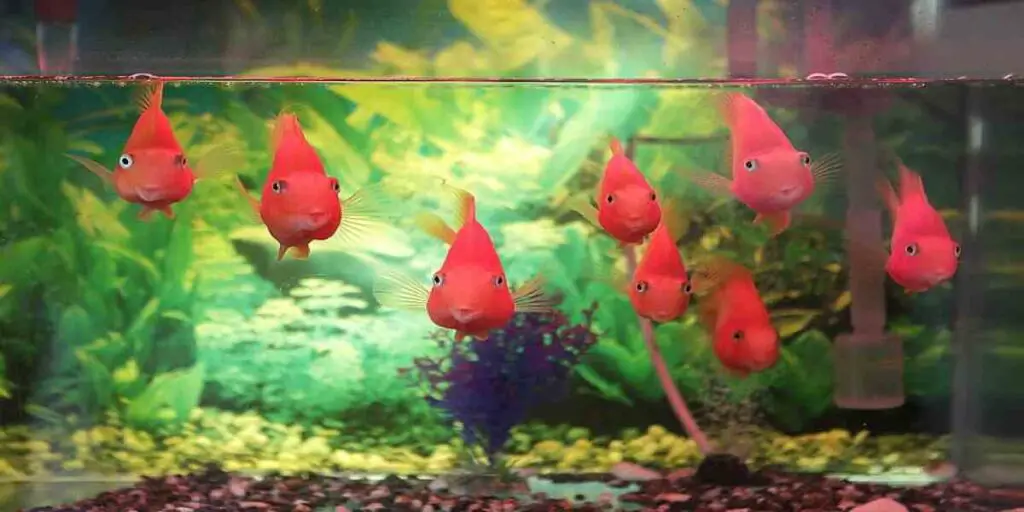After a water change, discover why yourfish staying at top of tank. Learn how to ensure their health and comfort in your aquarium. Find expert tips for maintaining a happy aquatic environment.

Aquarium keeping is a rewarding hobby, but it comes with its fair share of challenges. One common issue that many aquarium enthusiasts encounter is the sight of their fish congregating at the top of the tank after a water change. This behavior can be concerning, as it may indicate that something is amiss in your aquatic environment. In this article, we’ll delve into the reasons behind this behavior and explore ways to remedy the situation.
Understanding Fish Behavior After a Water Change
Before we dive into the potential causes and solutions, it’s crucial to understand why fish exhibit this behavior. Observing your fish swimming near the water’s surface, gasping for air, or appearing lethargic can be distressing, but it’s often a sign that your finned friends are trying to tell you something about their living conditions.
Common Reasons Why Fish Stay at the Top
a. Oxygen Levels: Fish breathe through their gills, extracting oxygen from the water. Inadequate oxygen levels can force them to seek oxygen-rich areas, usually near the surface. Low oxygen can be caused by various factors, including overstocking, poor aeration, or a sudden change in water conditions.
b. Water Quality: Fish are incredibly sensitive to changes in water quality. If your tank experiences ammonia or nitrite spikes after a water change, it can be toxic to your fish. They may rush to the surface in an attempt to escape the deteriorating water conditions.
c. Temperature and pH Shock: Rapid temperature or pH fluctuations can stress fish, leading them to hover near the surface. Sudden changes can be triggered by using water that’s too hot or too cold during a water change or altering the pH levels drastically.
d. Overcrowding: An overcrowded tank can lead to a lack of oxygen and increased waste production, both of which contribute to fish congregating at the surface. When there isn’t enough space for everyone to breathe comfortably, competition for oxygen intensifies.
How to Address the Issue
Now that we’ve identified some common reasons why fish may stay at the top of the tank after a water change, let’s explore practical steps to resolve these issues and help your fish thrive.
a. Properly Aerating Your Aquarium: Invest in a quality aquarium air pump and air stones to ensure adequate oxygen levels. These devices create surface agitation, which allows for better oxygen exchange. Make sure not to overdo it, as excessive bubbling can stress some fish.
b. Monitoring Water Quality: Regularly test your water for parameters such as ammonia, nitrite, nitrate, and pH. Use reliable test kits to maintain stable water conditions and address any spikes promptly. Consider adding beneficial bacteria supplements to help break down waste and maintain a healthy nitrogen cycle.
c. Gradual Water Changes: When performing water changes, aim for gradual adjustments in temperature and pH. Use a water conditioner to neutralize harmful chemicals in tap water and match its temperature to the tank water before adding it in. Smoother transitions reduce the risk of shock.
d. Providing Shelter and Hiding Spots: Create an environment that offers refuge for your fish. Rocks, caves, and aquatic plants provide places to hide and feel secure. These hiding spots can alleviate stress and encourage more natural behavior.
e. Regular Tank Maintenance: Maintain a regular cleaning schedule to prevent the buildup of organic waste and debris. Clean the substrate, change filter media when necessary, and ensure that your filtration system is functioning optimally.
Preventing Future Issues
Prevention is often the best medicine. To avoid fish congregating at the top of your tank, here are some proactive measures:
- Research Your Fish: Different species have varying requirements, so choose fish that are compatible with your tank size and each other. Research their specific needs to provide the best care.
- Avoid Overfeeding: Overfeeding can lead to excess waste and poor water quality. Feed your fish an appropriate amount and remove any uneaten food promptly.
- Quarantine New Fish: Before introducing new fish to your main tank, quarantine them in a separate container for a few weeks. This helps prevent the spread of diseases and allows you to monitor their health.
- Regular Water Changes: Perform routine water changes to maintain stable water parameters. Small, regular changes are often better than infrequent large ones.
You May Also Like:
- How Long After Putting Water Can I Add Fish
- Are Albino Cory Catfish Blind
- Fish At Top Of Tank After Water Change
Conclusion
In the world of aquarium keeping, understanding fish behavior is crucial for maintaining a healthy and thriving aquatic ecosystem. When your fish stay at the top of the tank after a water change, it’s a sign that something in their environment needs attention. By addressing issues related to oxygen levels, water quality, temperature, and pH fluctuations, overcrowding, and providing proper care, you can ensure that your fish are happy and vibrant.
Remember, a well-maintained aquarium not only benefits your fish but also enhances the beauty and tranquility of your living space. So, embrace the role of a responsible aquarist, and your finned friends will reward you with their mesmerizing beauty and graceful movements.